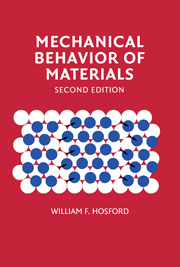Book contents
- Frontmatter
- Contents
- Preface
- 1 Stress and Strain
- 2 Elasticity
- 3 Mechanical Testing
- 4 Strain Hardening of Metals
- 5 Plasticity Theory
- 6 Strain Rate and Temperature Dependence of Flow Stress
- 7 Slip and Crystallographic Textures
- 8 Dislocation Geometry and Energy
- 9 Dislocation Mechanics
- 10 Mechanical Twinning and Martenitic Shear
- 11 Hardening Mechanisms in Metals
- 12 Discontinuous and Inhomogeneous Deformation
- 13 Ductility and Fracture
- 14 Fracture Mechanics
- 15 Viscoelasticity
- 16 Creep and Stress Rupture
- 17 Fatigue
- 18 Residual Stresses
- 19 Ceramics and Glasses
- 20 Polymers
- 21 Composites
- 22 Mechanical Working
- APPENDIX I Miller Indices
- APPENDIX II Stereographic Representation of Orientations
- Index
11 - Hardening Mechanisms in Metals
Published online by Cambridge University Press: 05 June 2012
- Frontmatter
- Contents
- Preface
- 1 Stress and Strain
- 2 Elasticity
- 3 Mechanical Testing
- 4 Strain Hardening of Metals
- 5 Plasticity Theory
- 6 Strain Rate and Temperature Dependence of Flow Stress
- 7 Slip and Crystallographic Textures
- 8 Dislocation Geometry and Energy
- 9 Dislocation Mechanics
- 10 Mechanical Twinning and Martenitic Shear
- 11 Hardening Mechanisms in Metals
- 12 Discontinuous and Inhomogeneous Deformation
- 13 Ductility and Fracture
- 14 Fracture Mechanics
- 15 Viscoelasticity
- 16 Creep and Stress Rupture
- 17 Fatigue
- 18 Residual Stresses
- 19 Ceramics and Glasses
- 20 Polymers
- 21 Composites
- 22 Mechanical Working
- APPENDIX I Miller Indices
- APPENDIX II Stereographic Representation of Orientations
- Index
Summary
Introduction
The strengths of metals are sensitive to microstructure. Most hardening mechanisms involve making dislocation motion more difficult. These include decreased grain size, strain hardening, solid solution hardening, and dispersion of fine particles. With finer grain sizes, there are more grain boundaries to impede dislocation motion. Metals strain harden because deformation increases the number of dislocations, and each interferes with the movement of others. In solid solutions, solute atoms disrupt the periodicity of the lattice. Fine dispersions of hard particles create obstacles to dislocation motion. Martensite formation and strain aging in steels are sometimes considered separate mechanisms, but these are related to the effects of interstitial solutes on dislocations.
Crystal Structure
Crystal structure strongly affects hardness and yield strength. Fcc metals tend to have higher strengths than bcc metals and lower strengths than hcp metals. The effect of crystal structure is most apparent in metals that transform from one crystal structure to another. Figure 11.1 shows how the hardness of nearly pure iron changes with temperature. The general decrease of hardness with increasing temperature is interrupted by the α → γ transformation at 910°C. At 910°C, the fcc structure is harder than the bcc structure. The reason the bcc structure is softer is at least partially explained by its greater number of slip systems. Similarly, the hardness of titanium would be expected to undergo a sharp drop as it transforms from hcp because there are fewer slip systems in hcp crystals than bcc ones.
- Type
- Chapter
- Information
- Mechanical Behavior of Materials , pp. 184 - 198Publisher: Cambridge University PressPrint publication year: 2009



